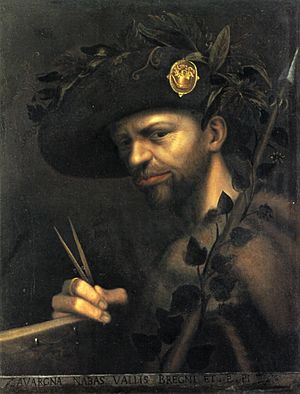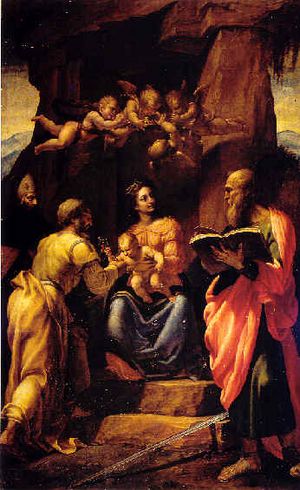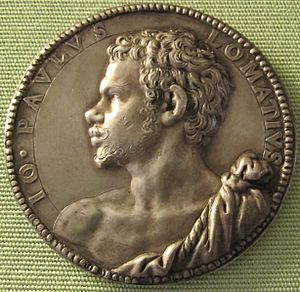Gian Paolo Lomazzo facts for kids
Quick facts for kids
Giovanni Paolo Lomazzo
|
|
|---|---|

Self-portrait
|
|
| Born | 26 April 1538 |
| Died | 27 January 1592 (aged 53) Milan
|
| Nationality | Italian |
| Known for | Painting, art criticism |
| Movement | Italian Renaissance |
Giovanni Paolo Lomazzo (born April 26, 1538 – died January 27, 1592) was a talented Italian artist. He was known for both his paintings and his writings about art.
Lomazzo was a respected painter. But in 1571, he became blind. This meant he had to change his career path. He then focused on writing about how art is made and what makes it good. His books were very important for a style of art called Mannerism in Italy.
Early Life and Artworks
Giovanni Paolo Lomazzo was born in Milan, Italy. His family had moved there from a town called Lomazzo. He learned to paint from Giovan Battista della Cerva in Milan.
Lomazzo created many important artworks. One of his large paintings was Allegory of the Lenten Feast. This painting was made for a church in Piacenza in 1567. He also painted a beautiful dome in San Marco church in Milan. This dome showed the Glory of Angels. Another work in the same chapel was The Fall of Simon Magus.
Around 1560, a medal was made by Annibale Fontana that showed Lomazzo. It suggested that he was introduced to good fortune and success.
Writing About Art
After losing his sight in 1571, Lomazzo started writing. He wrote two important books that helped shape how people thought about art. These books are still studied today.
His first major book was Trattato dell'arte della pittura, scoltura et architettura. It was published in 1584. This book had seven parts. It covered topics like how to show size and distance (Proportion), how to show movement (Motion), and how to use colors and light. It also talked about the history of art and the meaning behind symbols in classical and Christian art. Lomazzo's ideas helped create the rules for aesthetics (what makes something beautiful) in the Mannerist art style. This book was even translated into English in 1596.
Lomazzo's second book was called Idea del tempio della pittura (which means "The Ideal Temple of Painting"). It came out in 1590. This book was more about ideas. It discussed the "four temperaments" of human nature and how a person's unique personality affects their art.
Lomazzo's writings looked at three main parts of art criticism:
- Doctrina: This was about the new discoveries artists made over time, like how to use perspective to create depth.
- Prattica: This focused on an artist's personal style and choices.
- Iconography: This was about the stories and meanings behind the art.
Lomazzo was important because he went beyond just describing beautiful artworks. He looked for deeper ideas and concepts within art.
Some of Lomazzo's students included Giovanni Ambrogio Figino, Cristoforo Ciocca, and Girolamo Ciocca.
See also
 In Spanish: Giovanni Paolo Lomazzo para niños
In Spanish: Giovanni Paolo Lomazzo para niños



